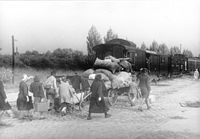
Photo from wikipedia
Abstract Objective To analyse the demographic and clinical characteristics of people attending physical rehabilitation centres run or supported by the International Committee of the Red Cross in countries and territories… Click to show full abstract
Abstract Objective To analyse the demographic and clinical characteristics of people attending physical rehabilitation centres run or supported by the International Committee of the Red Cross in countries and territories affected by conflict. Methods Of 150 such rehabilitation centres worldwide, 38 use an electronic patient management system. We invited all 38 centres to participate. We extracted de-identified data from 1988 to 2018 and categorized them by sex, age, country or territory and reason for using rehabilitation services. Findings Thirty-one of the 38 rehabilitation centres in 14 countries and territories participated. We included data for 287 274 individuals. Of people using rehabilitation services, 61.6% (176 949/287 274) were in Afghanistan, followed by 15.7% (44 959/287 274) in Cambodia. Seven places had over 9000 service users each (Afghanistan, Cambodia, Gaza Strip, Iraq, Myanmar, Somalia and Sudan). Overall, 72.6% (208 515/287 274) of service users were male. In eight countries, more than half of the users were of working age (18–59 years). Amputation was the most common reason for using rehabilitation services; 33.3% (95 574/287 274) of users were people with amputations, followed by 13.7% (39 446/287 274) with cerebral palsy. The male predominance was greater in the population aged 18–34 years (83.1%; 71 441/85 997) and in people with amputations (88.6%; 84 717/95 574) but was evident across all places, age groups and health conditions. Conclusion The considerably lower attendance of females at the rehabilitation centres highlights the need to understand the factors that affect the accessibility and acceptability of rehabilitation for women and girls in conflict settings.
Journal Title: Bulletin of the World Health Organization
Year Published: 2020
Link to full text (if available)
Share on Social Media: Sign Up to like & get
recommendations!